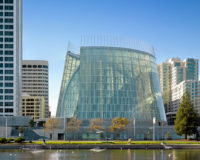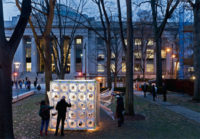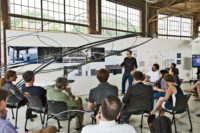Business Bay, Dubai, UAE
The showy skyscrapers that established Dubai's identity in this hot, humid, desert site on the Persian Gulf have been overshadowed by the towering Burj Khalifa. Yet one short office building ' a mere 22 stories' holds its own against Skidmore Owings & Merrill's 2,717-foot-high glass-and-steel behemoth. The diminutive office tower (347 feet high), designed by New York architects Reiser + Umemoto, stalwartly rises from a white, sandy lot in this instant city in the United Arab Emirates. It makes its mark by original means: with a holey, curvaceous outer shell.
Called 0-14 after the site number of the Business Bay district, the slim structure's dominant feature is a poured-concrete exoskeleton gouged with 1,326 blobby holes in five sizes. The architects intentionally sought to create an alien presence in the melange of banal towers. 'We embraced the radically abstract terrain of nowhere and its artificiality,' says Jesse Reiser.
The ghostly white exoskeleton stands 3 feet away from an inner glass-walled enclosure that follows its swerving contours: The two are linked by structural concrete tongues. With a central stair and elevator core, the interiors are column-free, allowing each floor to provide 6,000 square feet (net) of office space to its tenants.
Jesse Reiser and Nanako Umemoto, best known for winning international architectural competitions, got this commission unexpectedly in 2005. They had entered a competition for another site in the Business Bay district, held by Dubai Properties. While they lost the project to Zaha Hadid (still unrealized), their scheme piqued the interest of one of the developers, Shahab Lutfi, who was about to open his own office. By coincidence Lutfi was working with a Dubai architect, Khalid Alnajjar, who had studied under Reiser at Columbia University's architecture school, and highly recommended the team.
In an early version, the architects conceived the 0-14 building as an amorphous shape with glazed apertures. But the problems of placing gaskets around the glass and connecting the shaft to the concrete floors convinced the firm to develop a double-layered structure. By separating a concrete exoskeleton from a glazed concrete deck and core tower by 3 or more feet, the architects found the residual space would create a stack effect that takes hot air out of the building. Furthermore, the solar protection afforded by the curvilinear outer cylinder reduced cooling expenses by about 30 percent. Since the glass is shielded, it didn't need to be high-performance, although the team specified tinted glazing that would appear to recede farther behind the facade.
The master plan for Business Bay calls for towers on a podium that contain parking, with street-level arcades linking to retail shops and building lobbies. Reiser + Umemoto convinced the developer to place parking underground on this 34,000-square-foot site and have a two-story elevated podium wrap the tower on three sides to accommodate more office space and a restaurant. The revision meant the front facade could still be read as monolithic and scaleless, while elevating the podium allows pedestrians access to a plaza at the back overlooking the bay. A truss spans the rear of the podium to keep the ground less cluttered by columns, and bridges on two levels link the podium to the tower.
Since the exoskeleton would offer lateral resistance to wind, the architects and engineers found that the elevator core and the concrete shell could be lighter than normal. The shell, which Reiser refers to as 'atectonic,' lacks any break in its surface, including expansion joints. But the hole-ridden, contoured slipcover of concrete required a dense basket weave of rebar ' its underlying 'structural tectonic,' in Reiser's words. The team tied the rebar at intersections with stirrups in the zones of high stress, creating a diagrid with 40 percent openness.
The concrete pour offered its own challenges since the subcontractors ignored the architects' 3-D modeling of the formwork for the holes. Their own methods turned out to be OK, says Reiser, but some deformation of the foam forms in the holes at the bottom required wrapping them with melamine laminate.
Inside the 398,655-square-foot tower, occupants are protected from the high heat and gusts of sandy wind, while they still have expansive views out. In some respects the design could provide an influential prototype for other desert buildings. It comes as no surprise that the sculptural solution was expensive to build. Although the design saves in cooling costs, the up-front investment, withheld by the developer, was higher than a conventional structure, Reiser notes. Like many high-rise buildings erected in far-flung places, the willingness of clients, particularly before the economic free fall of 2008, has encouraged a liberty to experiment that could provide technical and sustainable lessons for the next building boom. Whenever that comes.
Owner: Creekside Development Company (subsidiary of District Investment & Development LLC)
Developer: Shahab Lufti, H&H Investment & Development LLC
Completion Date: January 2010
Gross square footage: 398,655 sq. ft.
Architect
Reiser + Umemoto
118 E 59 st. Suite 402
New York, NY 10022
Phone: (212) 421-8880
Fax: (212) 421-8881
PeopleArchitect Developer Personnel in architect's firm who should receive special credit: Architect of record Structural Engineer(s) Local Structural Engineer Consultant(s) General contractor Photographer CAD system, project management, or other software used |
ProductsStructural system Exterior cladding Windows–See Metal/Glass Curtain Wall Manufacturer (above) Glazing –See Metal/Glass Curtain Wall Manufacturer (above) Furnishings Lighting |


















Post a comment to this article
Report Abusive Comment